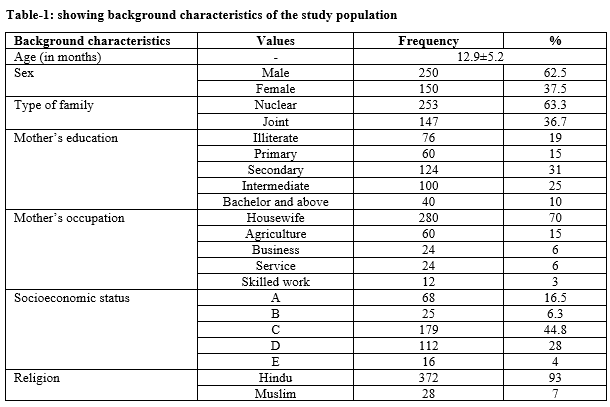Study on factors affecting complementary feeding practices in infants and young children in a rural area of Bihar
Abstract
Introduction: Proper infant and young child feeding practices are essential for the prevention of childhood morbidity and mortality. NFHS-4 reported that about half of the children in Bihar are not receiving complementary foods timely. The present study was conducted to assess the factors affecting the complementary feeding of infants and young children.
Methods: The present cross-sectional study was conducted upon mothers/ caretakers of 400 children age 6-24 months. Sociodemographic details and complementary feeding practices were noted.
Results: The mean age of initiation of complementary feeding was 5.2 months. Cereals were the most common complementary food given while only 19% of children received food from all the food groups. Half of the children (50.8%) were given food of appropriate consistency and 41% were given the proper amount. 53.8% were given marketed foods. A significant association was seen between ideal practices and type of family (p=0.002), mother’s education (p=0.000), socioeconomic status (p=0.000) and IYCF related advice given during immunization sessions (p=0.000).
Conclusion: Appropriate feeding practice is very low and effort should be made to increase the appropriate feeding practices.
Downloads
References
Black R. Maternal and child undernutrition: global and regional exposures and health consequences. Lancet 2008;371(9608):243-260. doi: https://doi.org/10.1016/s0140-6736(07)61690-0.
National Family Health Survey - 4 2015 -16. NFHS-4 Bihar FactSheet 2016.Available at http://rchiips.org/NFHS/pdf/NFHS4/BR_FactSheet.pdf.
Aggarwal A, Verma S, Faridi MMA, Dayachand. Complementary feeding- Reasons for inappropriateness in timing, quantity and consistency. Indian J Pediatr. 2008;75(1):49-53. doi: https://doi.org/10.1007/s12098-008-0006-9.
Ahmad I, Khalique N, Khalil S, Urfi, Maroof M. Complementary feeding practices among children aged 6–23 months in Aligarh, Uttar Pradesh. J Family Med Prim Care. 2017;6(2):386-391. doi: https://doi.org/10.4103/jfmpc.jfmpc_281_16.
Javalkar SR, Aras RY. A study on complementary feeding practices among mothers in urban and rural areas. Int J Comm Med Public Health. 2018;5(3):1162-1166. doi: https://doi.org/10.18203/2394-6040.ijcmph20180777.
Rao S, Swathi PM, Unnikrishnan B, Hegde A. Study of complementary feeding practices among mothers of children aged six months to two years – A study from coastal south India. AMJ. 2011;4(5):252-257. doi: https://doi.org/10.4066/AMJ.2011.607.
Yadav R, Singh P. Knowledge attitude and practices of mothers about breast-feeding in Bihar. Indian J Comm Med. 2004;29(3):130-131.
Dhami MV, Ogbo FA, Osuagwu UL, Agho KE. Prevalence and factors associated with complementary feeding practices among children aged 6–23 months in India: a regional analysis. BMC Public Health. 2019;19:1034. doi: https://doi.org/10.1186/s12889-019-7360-6.

Copyright (c) 2020 Author (s). Published by Siddharth Health Research and Social Welfare Society

This work is licensed under a Creative Commons Attribution 4.0 International License.


 OAI - Open Archives Initiative
OAI - Open Archives Initiative


